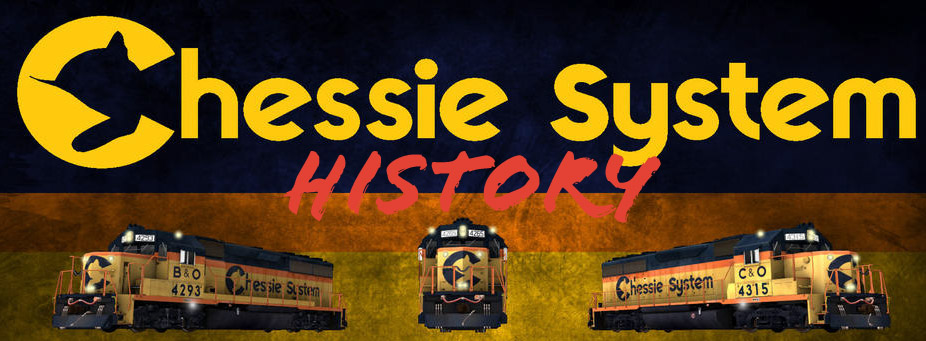This post looks at the start of the association and acquisition of control of the Baltimore and Ohio (B&O) by the Chesapeake and Ohio (C&O) as part of the lead up to the formation of the Chessie System. The B&O first coming under control of the C&O was not a merger, but was about saving and rehabilitating the B&O, making it stronger and better able to serve the public. Both roads would maintain their identities as they merged into the Chessie System and CSX up until 1986, when they were merged into CSX Transportation. See “The C&O-B&O Unity, the beginning of the Chessie System” for an introduction.
On January 7, 1960, four old railroad acquaintances got together to discuss the evolving trend toward mergers. The four men were associated with Robert Young, the former president of the C&O, who was at the center of eastern merger movements with the C&O as his chief playing card and kingmaker. Allan Kirby was Young’s financier at the Alleghany Corporation, which controlled the New York Central, Alfred Perlman, who ran the Central, and Cyrus Eaton and Walter Tuohy, the chairman and president of the C&O. Nothing came out of this meeting, but it would be followed by further discussions on the C&O gaining control of the B&O.
Then, at a dinner in Washington in late March 1960, Tuohy told Howard Simpson (president of the B&O) that the C&O was ready to go with a planned consolidation with the B&O that was not a merger. Eaton once told Perlman that the C&O was interested in “diversification outside of railroading rather than mergers within” (Saunders 187: 2001). The C&O was interested in getting 80 percent of B&O stock to meet the IRS requirement that would allow for the C&O to reduce its taxes with B&O losses and debts. The C&O wanted to move quickly and there was no time for extensive studies, Tuohy said, and there was no time for extensive studies. The future talks in April would be only between the C&O and the B&O, excluding Perlman and the Central. Perlman would become a constant thorn of opposition even after the B&O accepted the C&O’s offer in May 1960 and the idea of a three way association with the Central was not going to happen (Toothman 1993). With the announcement of the agreement between the C&O and B&O, states Fred Toothman, is where the relationship between the two roads began.
Summary of what the C&O wanted:
- Control of the B&O that was not a merger;
- Acquiring 80% of B&O stock that would allow to file a joint tax return;
- To make the B&O stronger and better;
- Prevent the B&O from sinking into bankruptcy;
- Give the B&O the expertise of successful C&O management;
- Allow the C&O some diversification.
The New York Central was not done trying to insert itself into the C&O-B&O association (as we shall see in later posts). In December 1960, Central began buying large chunks of B&O stock despite its poor financial position. The C&O offered B&O stockholders 1 ¾ shares of C&O stock for every 1 share of B&O stock. After getting enough stock to insure control (51%), President Tuohy and John Kusik, his financial vice president, made two trips to Switzerland to acquire enough B&O stocks from Swiss banks to insure the 80% needed to file the joint tax return. The Central eventually sold its large interest in the B&O to the C&O in March 1964 (Dixon and Huddleston, 1986).
With victory in hand, the C&O then turned to making its case for control of the B&O to the Interstate Commerce Commission, or ICC. The hearings before the ICC started on June 19, 1961 to determine if the C&O’s control of the B&O was in the public interest. The C&O first argued that it needed control of the B&O quickly to prevent the B&O from sinking into bankruptcy. The C&O’s best argument would be that it would underwrite the remainder of the B&O’s entire improvement program. The C&O promised the B&O the technical and managerial expertise, along with wise investments that made the C&O very successful. The C&O had to make its arguments to the ICC, even though most people were sure the ICC would approve the C&O’s control wish list for the B&O, there would be opposition and compelling counter arguments, and we will look at these in the later posts.
References
Chessie News. 1962. Feb. 4 Next Big Day in B&O-C&O Timetable. December 17.
Chessie News. 1962. Presidents of B&O, C&O Hail ICC Decision. December 17.
Saunders, Richard. 2003. Main Lines: Rebirth of North American Railroads. 1970-2002.
Saunders, Richard. 2001. Merging Lines: American Railroads, 1900-1970.
Saunders, Richard. 1978. Railroad mergers and the coming of Conrail. Greenwood Press.
Toothman, Fred Rees. 1993. Working for the Chessie System: Olde King Coal’s Prime Carrier.
Turner, Charles W., Thomas W. Dixon and Eugene L. Huddleston. 1986. Chessie’s Road. 2nd addition. Chesapeake and Ohio Historical Society: Alderson, WV.
Watkins, Hays T. Just Call Me Hays. Recollections, Reactions and Reflections on 42 Years of Railroading. 2001.
